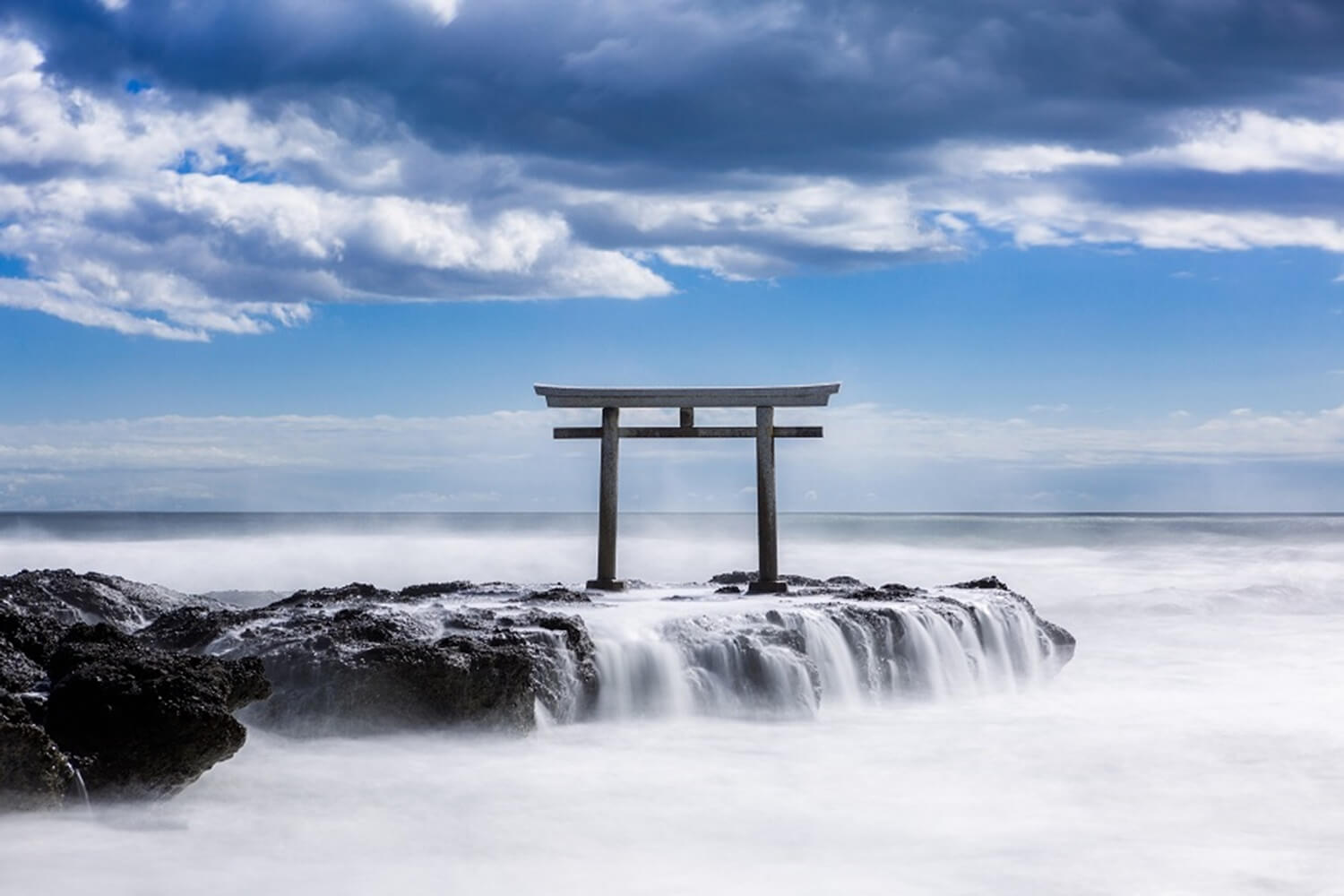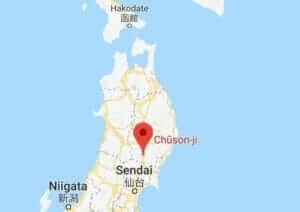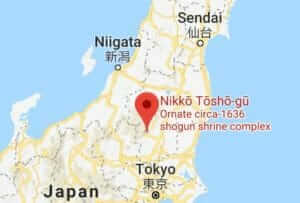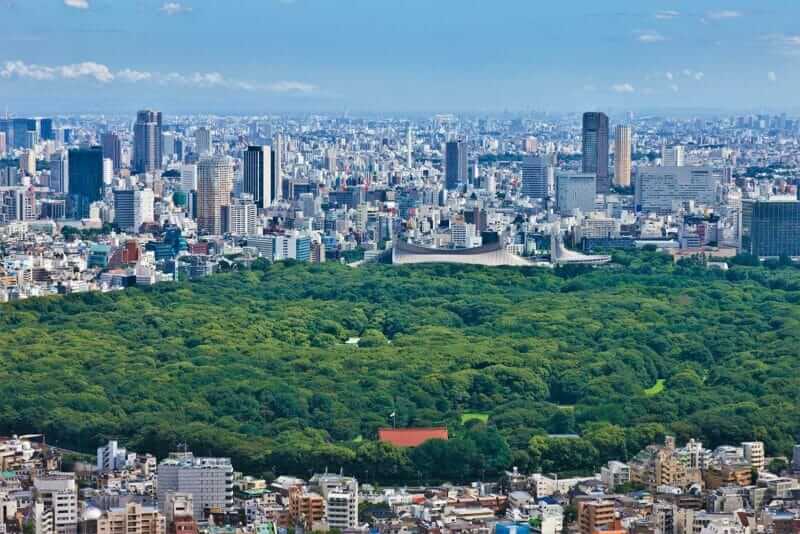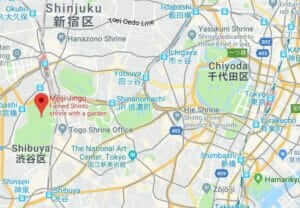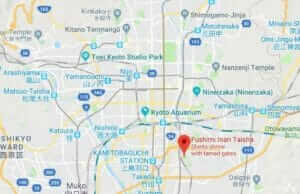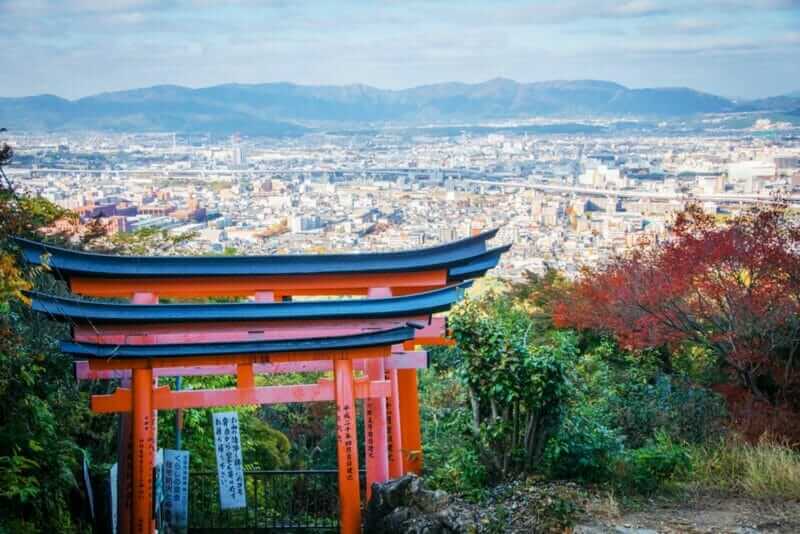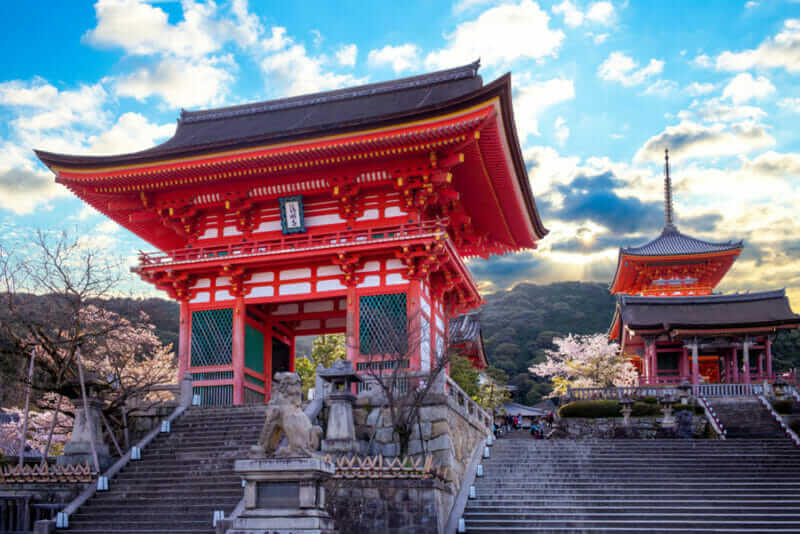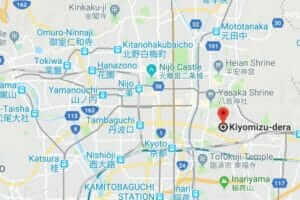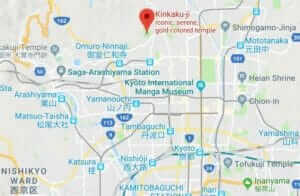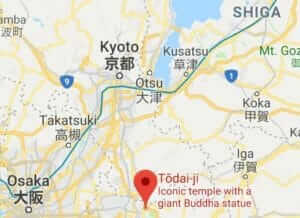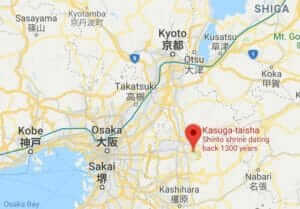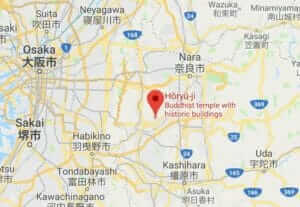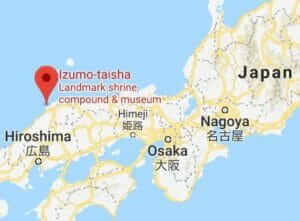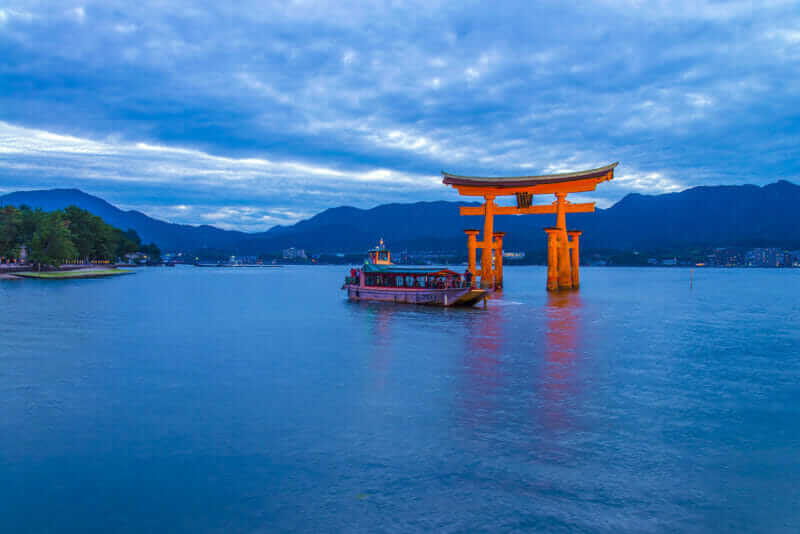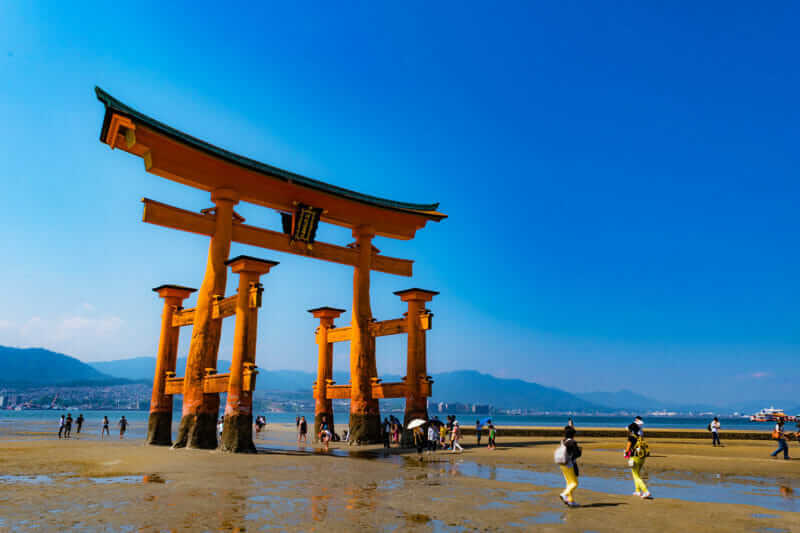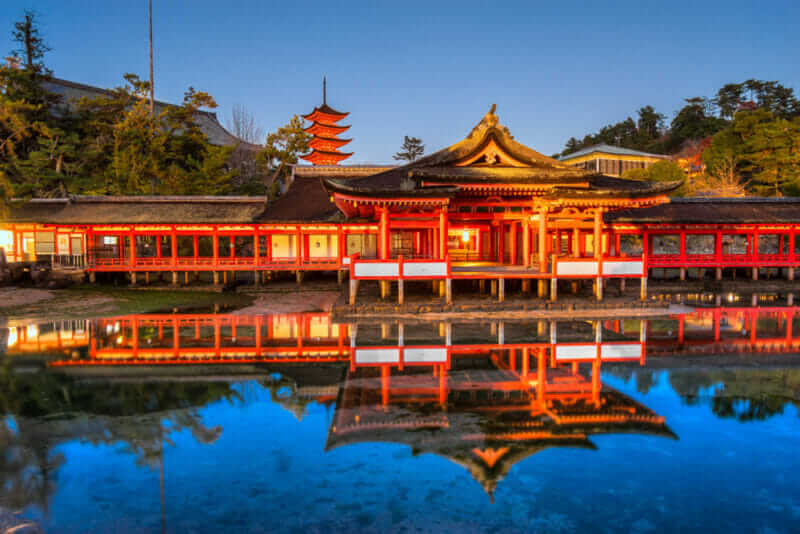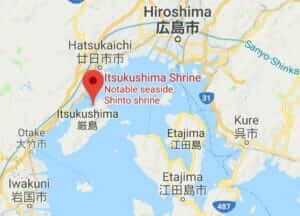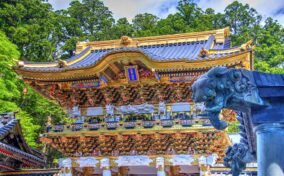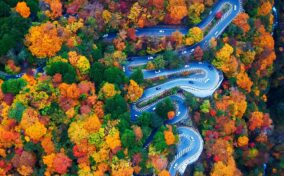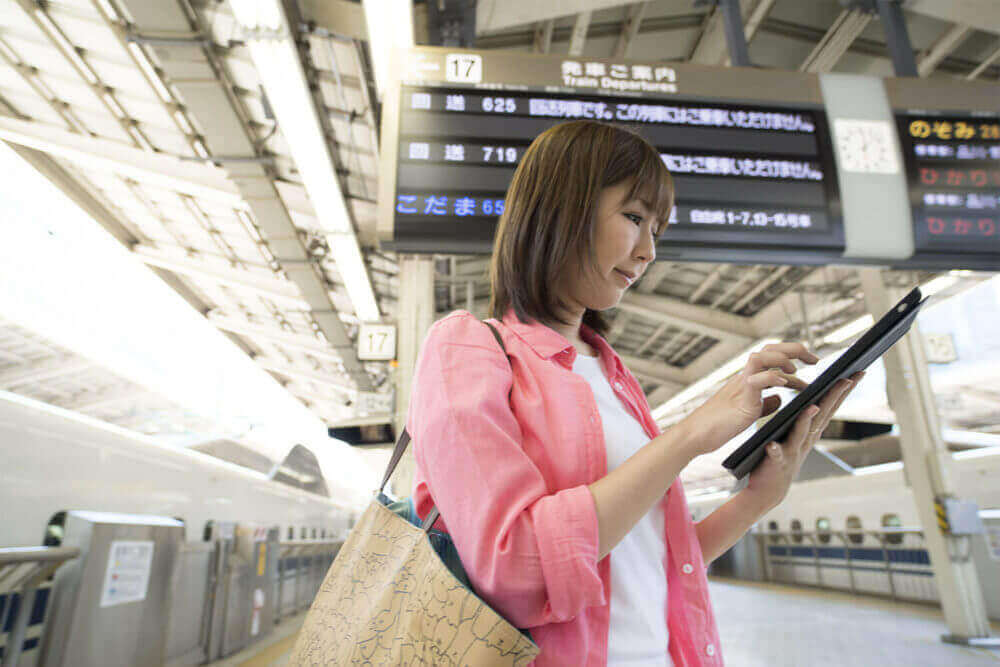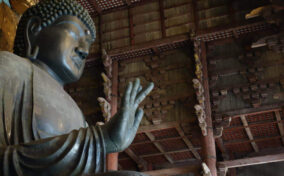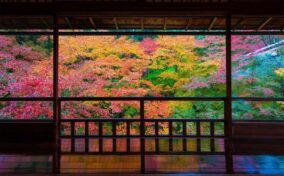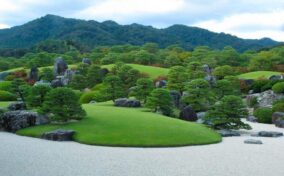There are many Buddhist temples and Shinto shrines in Japan. There are about 76,000 temples and about 80,000 shrines. (*Data from the Agency for Cultural Affairs, Religious Statistics Survey 2022)
Temples and shrines are important to Japanese people. It is a place of prayer. I go there when I am happy and when I am sad. Temples and shrines are places where you can relax and refresh your mind.
The temples and shrines introduced on this page are particularly famous among the numerous temples and shrines in Japan, and are popular spots visited by people all over Japan and around the world. They are extremely sacred, beautiful and solemn.
Be sure to include it in your itinerary when visiting Japan.
Click on each map to see related tour and nearby activity information on a separate page.
Table of Contents
- Japanese best temple: Chusonji Temple (Hiraizumi Town, Iwate Prefecture)
- Japanese best shrine: Nikko Toshogu Shrine (Nikko City, Tochigi Prefecture)
- Japanese best temple: Sensoji Temple (Tokyo)
- Japanese best shrine: Meiji-jingu Shrine (Tokyo)
- Japanese best shrine: Fushimi Inari Taisha Shrine (Kyoto)
- Japanese best temple: Kiyomizudera Temple (Kyoto)
- Japanese best temple: Kinkakuji Temple = Golden Pavilion (Kyoto)
- Japanese best temple: Todaiji Temple (Nara City, Nara Prefecture)
- Japanese best shrine: Kasugataisha Shrine
- Japanese best temple: Horyuji Temple (Ikaruga Town, Nara Prefecture)
- Japanese best shrine: Izumo taisha=Izumo Grand Shrine (Izumo City, Shimane prefecture)
- Japanese best shrine: Itsukushima Shrine (Hatsukaichi Town, Hiroshima Prefecture)
Japanese best temple: Chusonji Temple (Hiraizumi Town, Iwate Prefecture)
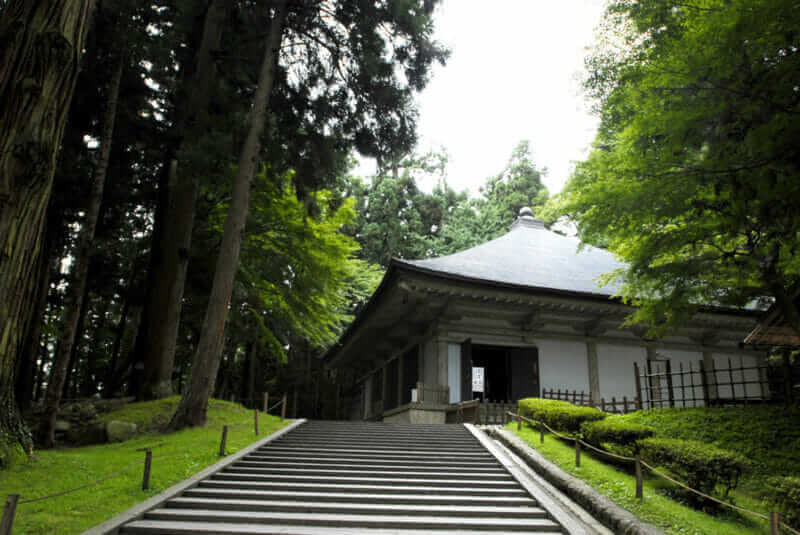
Chusonji Temple KONJIKIDOU Appearance = shutterstock
Chusonji is a very famous Buddhist temple in the town of Hiraizumi in the Tohoku region, Japan. In the Tohoku region, the course which goes around the four temples of this Chusonji, Motuji Temple (Hiraizumi Town), Risshakuji Temple (Yamagata city), Zuiganji Temple (Matsushima Town, Miyagi prefecture) is popular.
Chūsonji Temple is designated as a special historic site and it was listed as a UNESCO World Heritage Site as a part of the “Historic Monuments and Sites of Hiraizumi” in 2011. This temple is famous for the building called “Konjiki-do” . Konjiki-do is a buddha hall covered with gold foil both outside and inside of the building. As shown in the above picture, currently, this buddha hall is in a concrete building so as not to be exposed directly to the wind and rain.
In order to fully enjoy Chusonji sightseeing, you should know the history of this temple. Built in 850, Chusonji was reborn as a huge temple by Fujiwara no Kiyohira who governed the entire Tohoku region in the first half of the 12th century. It is said that Chusonji consisted of over 40 huge buildings. There was Konjiki-do in the center. Fujiwara no Kiyohira hoped to lose all conflicts from the Tohoku region by the power of the Buddha.
When he was a child, his father was killed with a rusted saw by the army dispatched from Kyoto. He was about to be killed. However, his mother became the wife of the man who killed his husband, so her son was saved his life. About 25 years later Fujiwara no Kiyohira was killed by his half-brother his wife and children. For this reason he had no choice but to kill his half-brother.
In the background that such tragedies happened, there was the fact that the court in Kyoto gradually began to expand its force to the Tohoku region. However, in Kyoto ‘s courtroom, there were two Samurai powers emerging afterwards, Genji and Heike. And Genji and Heike began fighting. In the courtroom of Kyoto, They no longer have the margin to care about the Tohoku region. For this reason, fortunately Fujiwara no Kiyohira succeeded in building an independent peaceful era in the Tohoku region.
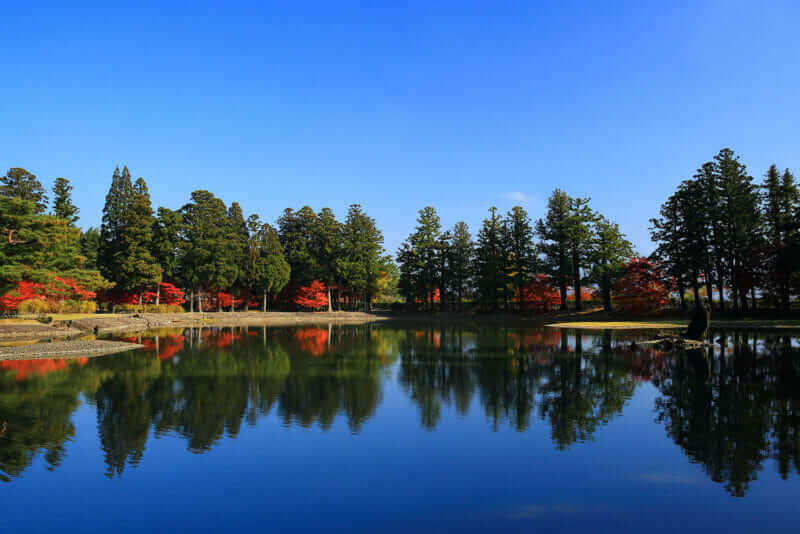
At Motsuji Temple near Chusonji, a vast pond built in the era of the Fujiwara family is left = AdobeStock
The Fujiwara family became very rich by the gold mined in the Tohoku region at that time. They also made trade with China. Later in the year, Italian Marco Polo told people in Europe that there is a golden country called Zipang in the Far East. It is said that the golden country he told was about the peaceful world that the Fujihara family built in the Tohoku region.
At the time, Chusonji and Motuji Temple near it were a group of buildings larger than the temples in Kyoto. However, the Fujiwara family was destroyed in 1189 by Genji samurai. Most of the buildings of Chusonji and Motuji Temple were destroyed by some fire after that. Most of the buildings you can see now, except Konjiki-do, were built afterwards.
Japanese best shrine: Nikko Toshogu Shrine (Nikko City, Tochigi Prefecture)
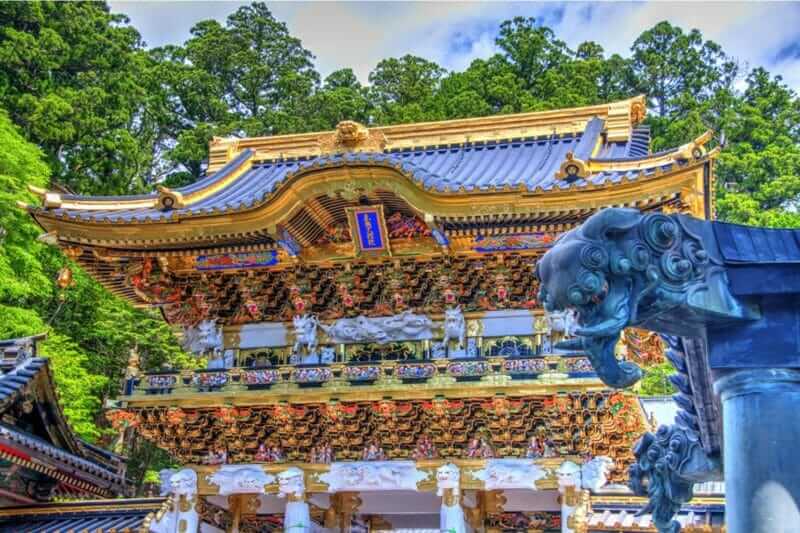
Yomeimon Gate in Toshogu Shrine, Nikko, Japan
Nikko Toshogu is a shrine located in Nikko city, Tochigi prefecture in the northern part of the Kanto region. To Nikko it takes about 2 hours by the limited express of Tobu Railway from Asakusa, Tokyo.
In Toshogu, Ieyasu TOKUGAWA, the founder of the Tokugawa shogunate which dominated Japan 300 years since the 17th century, is enshrined. In order to show the power of the Tokugawa shogunate to the people, the building of Toshogu has a very gorgeous sculpture.
Toshogu has more than 5000 sculptures. Among them, 500 is applied to the beautiful gate called Yomei gate. In addition to the Yomei gate there are also many sculptures in the front gate, corridor, hall of worship, main hall and so on. These sculptures are not mere decorations, but they carry a variety of symbolic meanings in the shrine dedicated to Ieyasu TOKUGAWA as “God”.
Ieyasu ordered his servants to bury himself in Nikko. Nikko is just in the north of Tokyo. Ieyasu was trying to protect Japan from its position even after death. Because of this background, there is a theme of “peace” in sculpture of Toshogu. For example, it is said that sculptures that cats are pleasantly sleeping mean that animals can feel peaceful. It can be said that Toshogu is like an art museum where you can appreciate many beautiful sculptures.
Near Toshogu Shrine, there is a beautiful area such as Lake Chuzenjiko. You will be able to have a fun day trip from Tokyo.
Japanese best temple: Sensoji Temple (Tokyo)
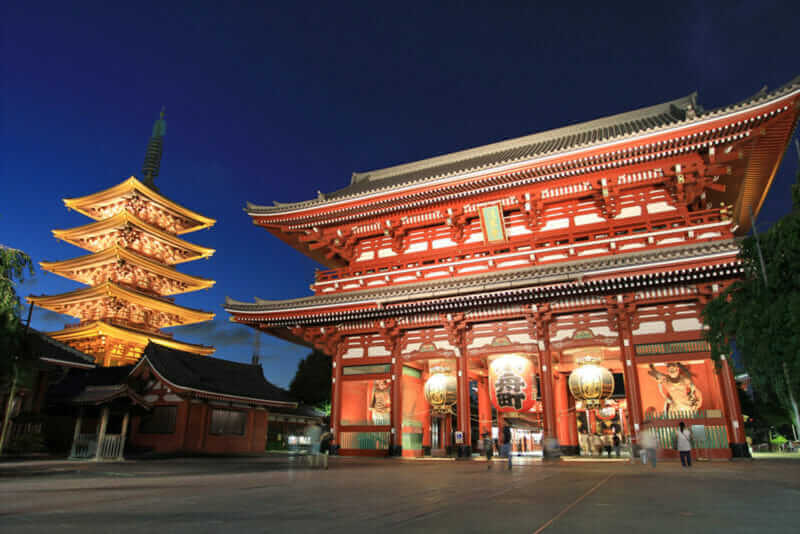
Senso-ji Temple, Asakusa, Tokyo, Japan = shutterstock
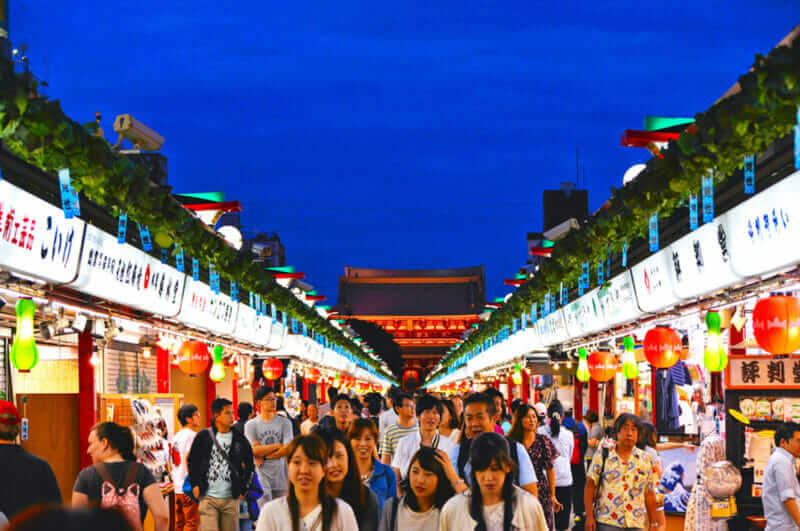
Night scene with Tourists enjoying at Nakamise shopping street in Asakusa connect to Sensoji Temple in Asakusa, one of the most popular places in Tokyo = shutterstock
Sensoji Temple is the oldest temple in Tokyo. It is crowded as the best tourist attraction of Asakusa which is the downtown of Tokyo. The most interesting part of Sensoji as a sightseeing spot is the shopping district called “Nakamise” where more than 100 stores continue from the big gate called “Kaminarimon” to the main hall. At these stores, you can buy various souvenirs and street foods in Tokyo. These shops are traditional in appearance and people in the shop are also friendly, so you can enjoy the traditional downtown culture in Tokyo.
Next to the main hall is a five-storied pagoda. You will be able to shoot landscapes that seem very Japanese.
Japanese best shrine: Meiji-jingu Shrine (Tokyo)

Entrance at Meiji-jingu temple in Central Tokyo, Japan = shutterstock

In Meiji Shrine, big trees are lining up. You can stroll through the forest until you reach the Main Hall. = shutterstock
Meiji-jingu is a famous shrine spreading next to JR Harajuku station in Tokyo. On the opposite side across this station, there is Harajuku, a town of young people. Contrary to this town, Meiji-jingu Shrine has a majestic atmosphere.
Meiji-jingu Shrine was built in 1920 to ward Emperor Meiji (1852-1912) and Empress. This shrine has a site area of 73 hectares. This shrine has a rich forest on this vast site.
There are several entrances to this shrine. If you enter this shrine from JR Harajuku station, you first go through the huge torii gate as seen in the picture above. It is about ten minutes’ walk from this torii gate to the main hall. You walk in a very beautiful woods.
There is a Japanese garden on the way. Admission fee will cost 500 yen per person to enter this garden. Meiji-jingu Shrine’s main hall is beautiful and huge. You will be a quiet sacred time in the city center of Tokyo.
Japanese best shrine: Fushimi Inari Taisha Shrine (Kyoto)
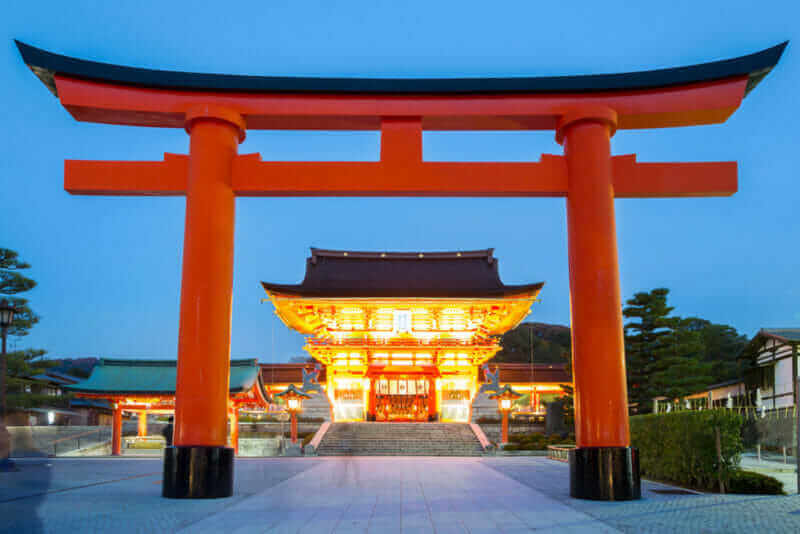
Fushimi Inari Taisha Shrine at dusk Kyoto Japan = shutterstock
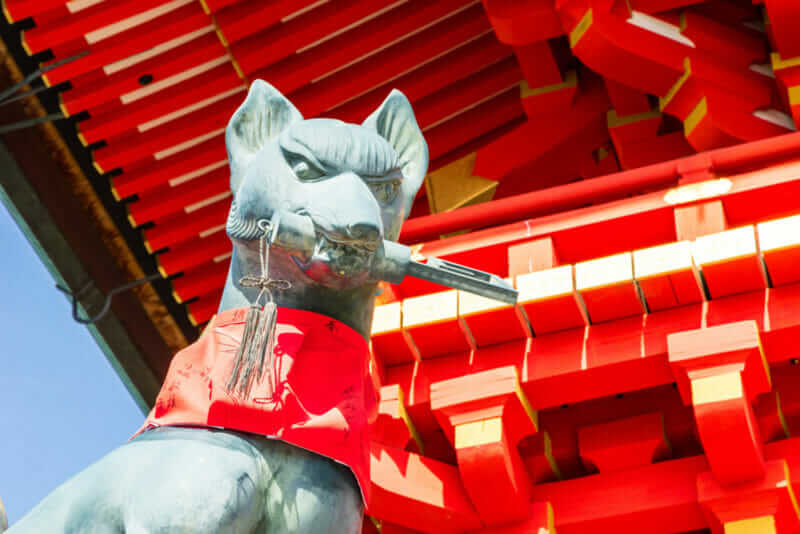
Fushimi inari stone fox guarda wooden gates. Foxes are believed to be messengers of god = shutterstock
Fushimi Inari Taisha Shrine is a huge shrine in the southeastern part of Kyoto city. Almost all of the low mountain with an altitude of 233 meters called Inari mountain is a shrine.
Fushimi Inari Taisha Shrine is one of the most popular tourist attractions among foreign tourists coming to Japan. Fushimi Inari Taisha Shrine has about 10,000 red torii gate. The sight that countless torii line up is very exotic. You go through these torii and head towards the main hall.
Inari shrine enshrines the god that brings good harvest to people. It is the fox who serves this god. For this reason, there are many fox statues in Inari shrine. There are about 30,000 such Inari shrines in Japan. Fushimi Inari Taisha Shrine is located at the top of those shrines. Fushimi Inari Taisha Shrine is said to have been built in the early 8th century.
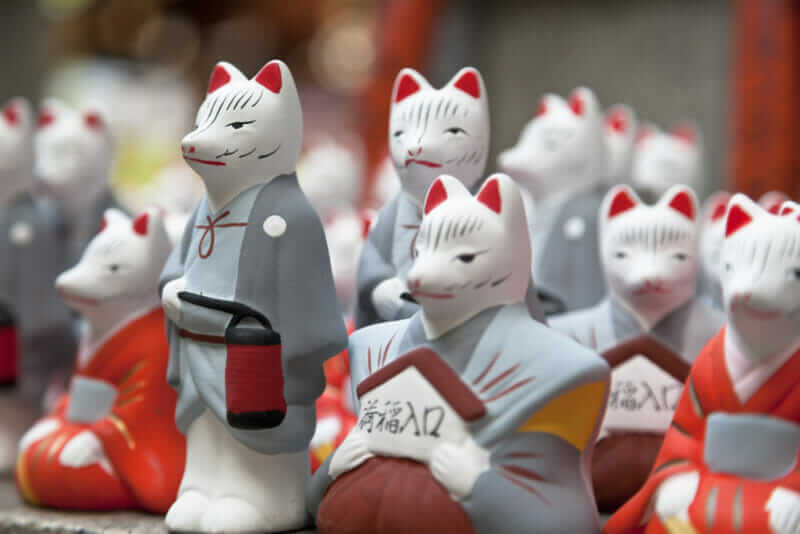
Statue of The Inari- fox at Fushimi Inari shrine, one of famous landmarks in Kyoto, Japan = shutterstock
Fushimi-Inari Taisha Shrine spreads almost all over Inari mountain. If you walk all that way, you will go down to the top of Inari mountain and come down from there. It takes about 2 hours to complete the entire journey. Many tourists turn back at the mountainside. However, if you go to the mountaintop of Inari mountain, you can watch the inside of Kyoto from the summit. Inari mountain is on the east side of Kyoto city, so you can see the beautiful sunset by going there in the evening.
Japanese best temple: Kiyomizudera Temple (Kyoto)
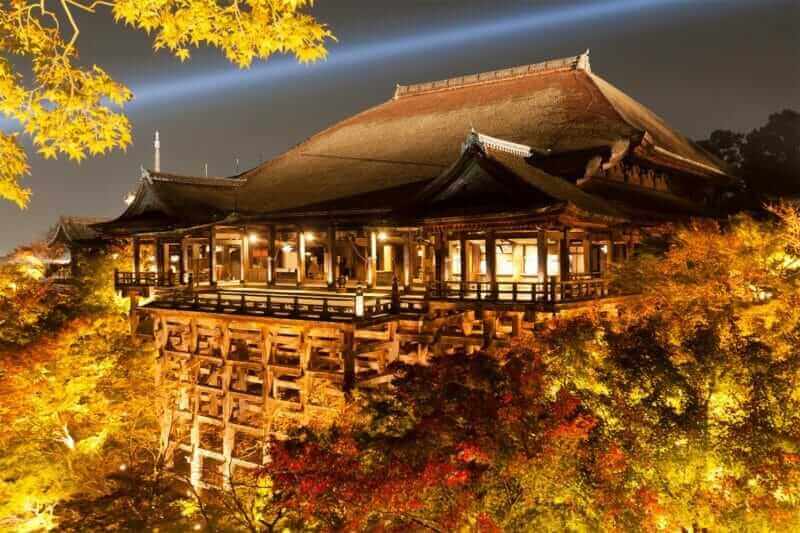
Main hall of Kiyomizudera Temple, Kyoto, Japan
Kiyomizudera Temple is a popular spot in Kyoto, along with Fushimi Inari Shrine, Kinkakuji and Arashiyama. Kiyomizudera Temple is located on the mountainside on the east side of Kyoto. Building stone walls on the slope of the mountain, many buildings are built on the foundation.
The main hall of Kiyomizudera Temple is very huge as seen in the picture above.
Kiyomizudera Temple is said to have been built in the 8th century. The current main hall was rebuilt in 1633. This hall is supported by about 140 long long zelkova trees. Nails are not used at all in this main hole. Unfortunately, at this main hall the restoration work of the roof is under way. You can watch great scenery from the main hall as usual, but you may find it difficult to shoot beautiful photos.
In addition to the main hall, Kiyomizudera Temple has beautiful buildings such as Nio-mon gate and triple tower in the above picture. Walking around all these buildings takes about an hour even when it is not crowded.
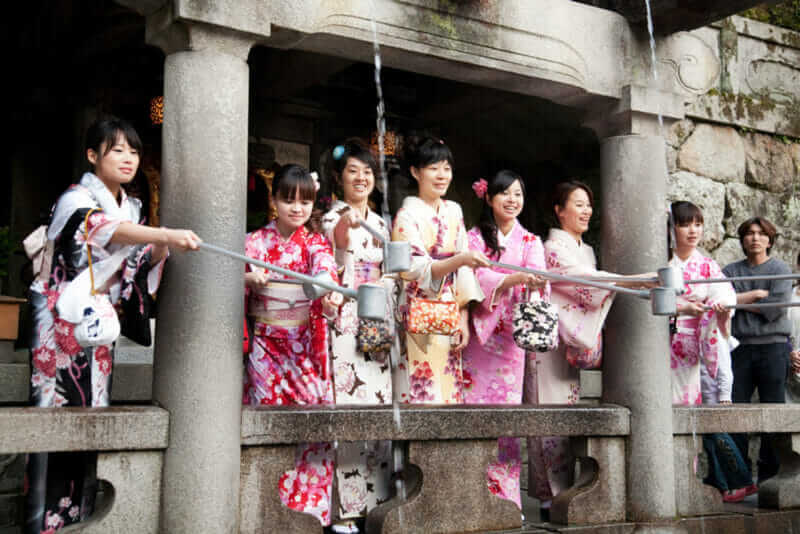
Many people collecting water from the Otowa-no-taki waterfall at Kiyomizu temple in Kyoto on 4th August 2010. Visitors believe that water have enhance healthy = shutterstock
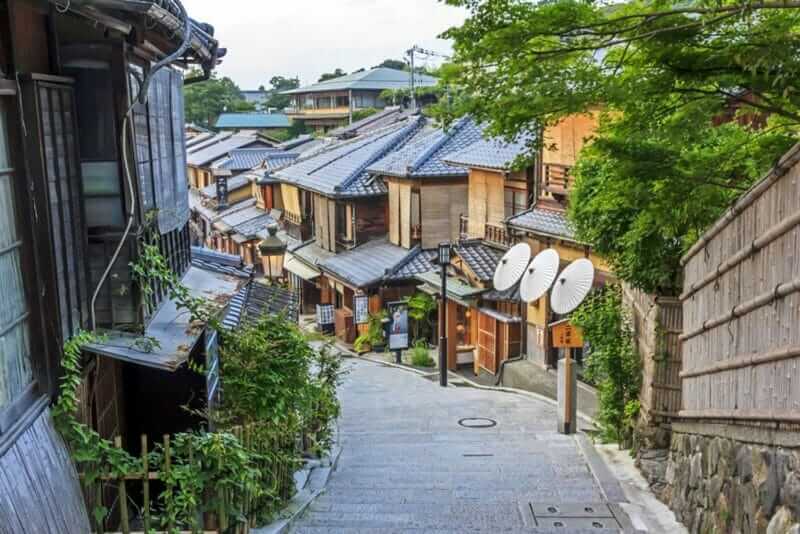
Beautiful old houses in Sannen-zaka street, Southern Higashiyama area. Sanene-zaka is one of the most beautiful streets in Kyoto = shutterstock
In the precincts there is a famous spring water called Otowa-no-Taki as seen in the photo above. This spring water continues to boil for over 1000 years. It is said that if you drink this water your wish will come true.
There are many souvenir shops and street food shops around the roads from Kiyomizudera Temple to the foot of the mountain. As you can see in the picture above, a very beautiful slope called “Snnei-zaka” is also nearby. If you go to Kiyomizudera Temple, I recommend you to take such a stroll around.
Japanese best temple: Kinkakuji Temple = Golden Pavilion (Kyoto)
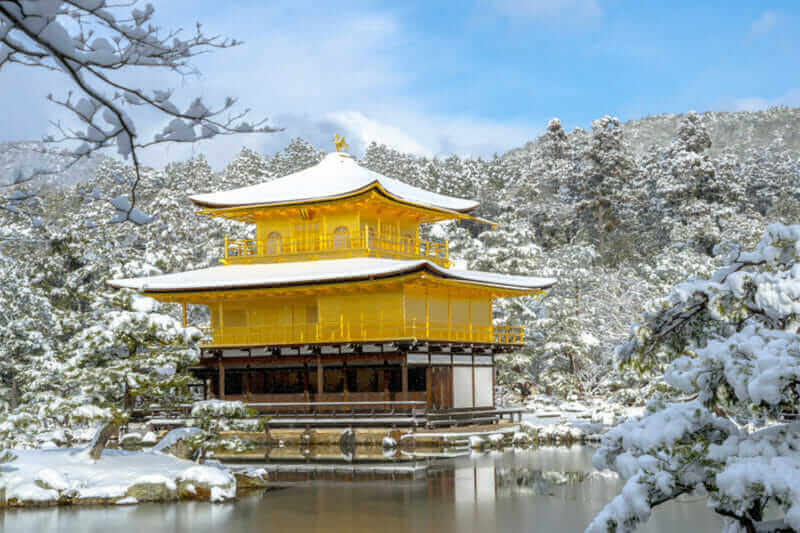
The Golden Pavilion (Kinkakuji) with snow in Winter Season
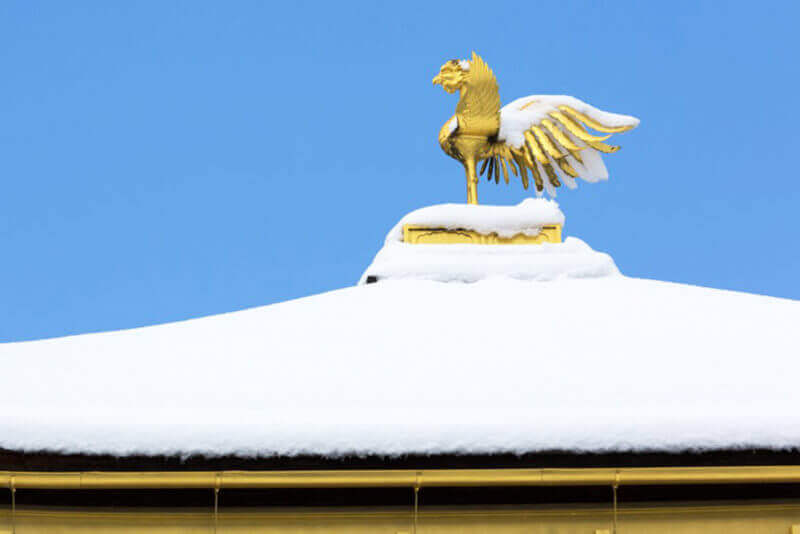
On the roof of the Golden Pavilion, the legendary bird “Houou” shines, Kyoto, Japan = shutterstock
Kinkakuji Temple (official name is Rokuonji Temple) is a temple located in northern part of Kyoto. It is a very popular tourist attraction by its Golden Pavilion whose top two floors are completely covered in gold leaf. The gold used for the Golden Pavilion is said to reach 20 kilometers.
The Golden Pavilion was built by the shogun Yoshimitsu ASHIKAGA in 1397. He was already retired after giving the position of shogun to his son at the time, but he continued to have real power. Following his will as he died, the Golden Pavilion was transformed into a Zen temple.
Unfortunately the Golden Pavilion was destroyed by arson in 1950. The current Golden Pavilion is a restored building afterwards.
The Golden Pavilion changes the scenery beautifully according to the seasonal change. This building is the most beautiful in autumn when the surrounding trees turn red. However, sometimes snow falls in Kyoto in winter. As the snow falls, the Golden Pavilion has a shiny atmosphere, as seen in the photo above. If you go to Kyoto in winter and snow falls, please go to Kinkakuji early in the morning. The scenery of Kinkakuji at that time should surely be unforgettable memories.
If you go to Kyoto, please also refer to the following article.
Japanese best temple: Todaiji Temple (Nara City, Nara Prefecture)

Great Buddha or Daibutsu, Todai-ji Temple or Roaming Deer its all belong to Nara city in Japan = shutterstock
Nara City is an ancient capital located in the south of Kyoto, about 35 minutes by Kintetsu Railway Express from Kyoto Station. Nara was the capital of Japan from 710 to 794 until the capital moved to Kyoto. Todaiji Temple is a huge temple representing this old capital.
Todaiji was built in the first half of the 8th century. In this temple, Great Buddha (Daibutsu) about 14.7 meters in height is settled. This Great Buddha was first completed in 758. The hall where the Great Buddha is rested (Daibutsu – den Hall) is currently about 50 meters tall. Great Buddha and Daibutsu-den Hall have been burned down due to a number of wars so far. The current Great Buddha was rebuilt in 1692 and Daibutsu-den Hall was rebuilt in 1709.
In the 8th century when Nara had the capital of Japan, Japanese learned a lot about Buddhism and other cultures from China. Thanks to that, Todaiji was born.
At the time, the government built temples called “Kokubunji” in various places to spread Buddhism throughout Japan. This Todaiji is located at the top of Kokubunji. The Great Buddha of Todaiji Temple is a symbol of the era when Japanese people absorbed Buddhism hard.
Japanese best shrine: Kasugataisha Shrine
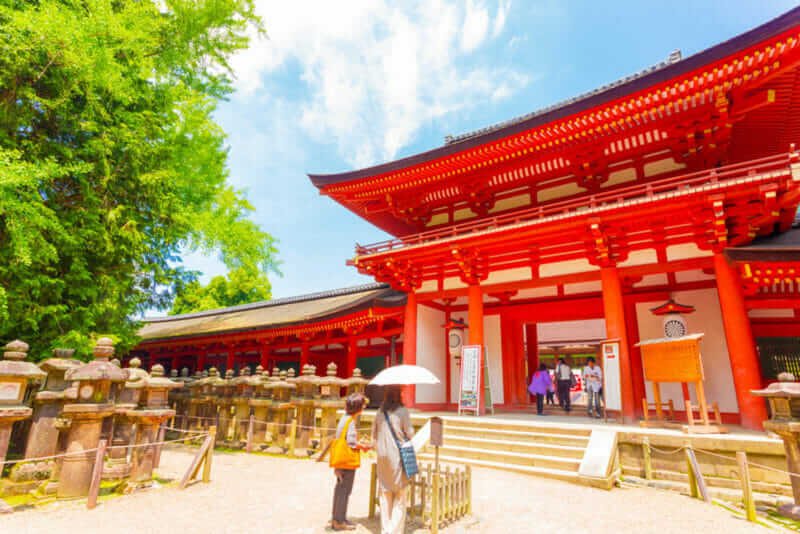
Japanese people at front red gate entrance to Kasuga-Taisha Shinto Shrine = shutterstock
Kasuga Shrine is the largest Shinto shrine in Nara built in the 8th century. This shrine is located near Todaiji Temple. This shrine was built to worship the guardian god of the Fujiwara family who had the most political power from the Nara era (714 – 794) to the Heian era (794 – 1185).
At Kasuga Taisha Shrine, photographing of the main hall is forbidden. For this reason, including this page, many of the guide books etc. are posted on the picture of the gate, not the picture of the main hall. Many lanterns donated by samurai and aristocrats have been lined up in Kasuga Taisha since ancient times. There are many bronze lanterns around the building. Every year, the lanterns are lit at the beginning of February and mid August. At that time the whole Kasuga Taisha Shrine is wrapped in a fantastic atmosphere.
At Kasuga Taisha Shrine, deer is regarded as a messenger of God. For this reason, there are so many wild deer in Kasuga Taisha.
Behind Kasuga Taisha Shrine, a vast primary forest of about 250 hectares is spreading. Deer lives in this virgin forest and Nara Park.
Japanese best temple: Horyuji Temple (Ikaruga Town, Nara Prefecture)
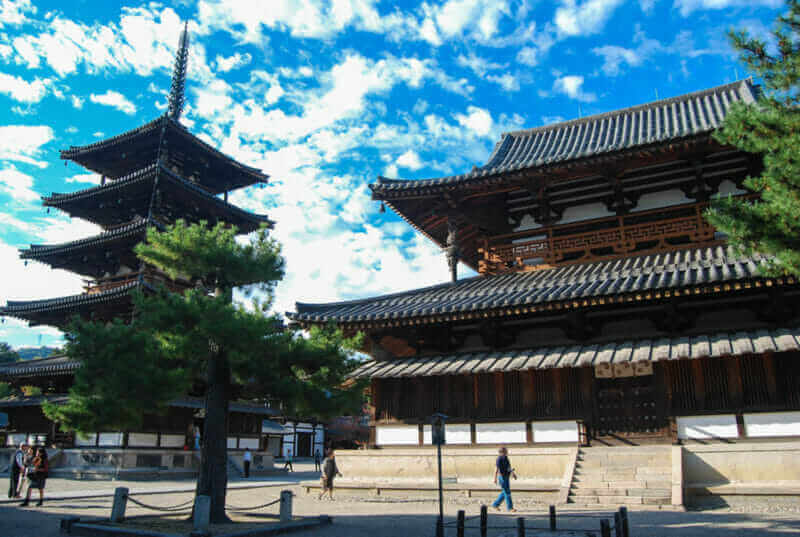
Listed as a World Heritage, Horyuji is a Buddhist temple and its pagoda is one of the oldest wooden buildings exist = ing in the worldshutterstock
If you want to feel Japanese culture even older than the Nara era, you may go to Horyuji Temple. Horyuji Temple is located in Ikaruga Town, Nara Prefecture.
This temple is said to have been built in 607. In Japan, it is called the Asuka period from 538 to 710. Horyuji Temple is a historical monument representing this era. Buildings such as the five-storied tower and Kondo (sanctuary hall) are the oldest wooden buildings in existence in the world. These buildings are registered as UNESCO World Heritage sites.
Horyuji Temple was built by Emperor Suiko and Prince Shotoku. Prince Shotoku was a very intelligent person, and dispatched excellent people to China and introduced Chinese culture to Japan. At that time, Buddhism was a very advanced culture. Prince Shotoku built Horyuji Temple to spread Buddhism in Japan. In the background that Prince Shotoku spread Buddhism, there was a constant conflict within the court. Prince Shotoku wanted to cultivate the harmony of people by spreading Buddhism.
If you go to Horyuji, please see the pillars such as Kondo and Central Gate remaining in the premises. Regarding the pillars of Horyu-ji Temple, a style called “entasis” which is often used in ancient Greek architecture is adopted. In this style, the middle of the pillar is bulging. This shows that the ancient Greek culture was transmitted to China through the Silk Road and was further transmitted to Japan. Please try to feel the culture of ancient Greece by all means in ancient capital of Japan.
Japanese best shrine: Izumo taisha=Izumo Grand Shrine (Izumo City, Shimane prefecture)
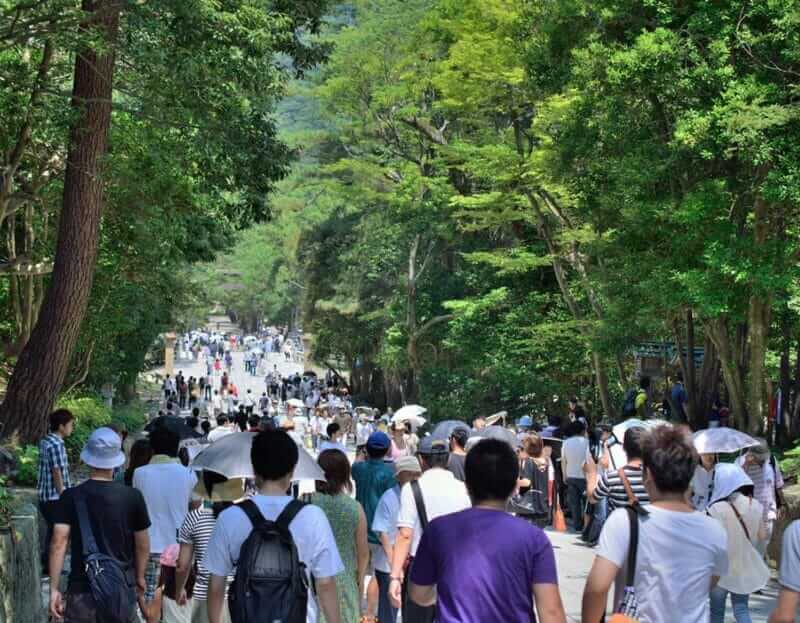
Entrance path to Izumo-taisha, one of the most ancient and important Shinto shrines. The shrine is designated National Treasures of Japan in 1952
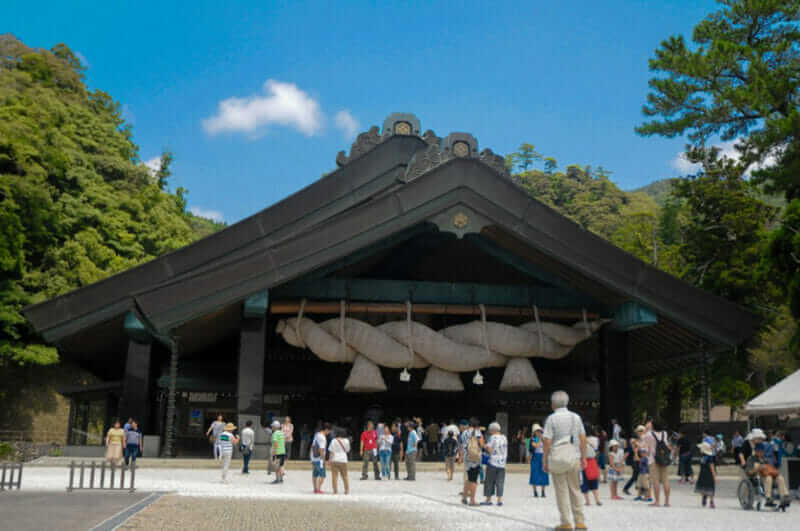
Izumo Taisha Shrine in Shimane, Japan. To pray, Japanese people usually clap their hands 2 times, but for this shrine with the different rule, they have to clap hands 4 times instead = shutterstock
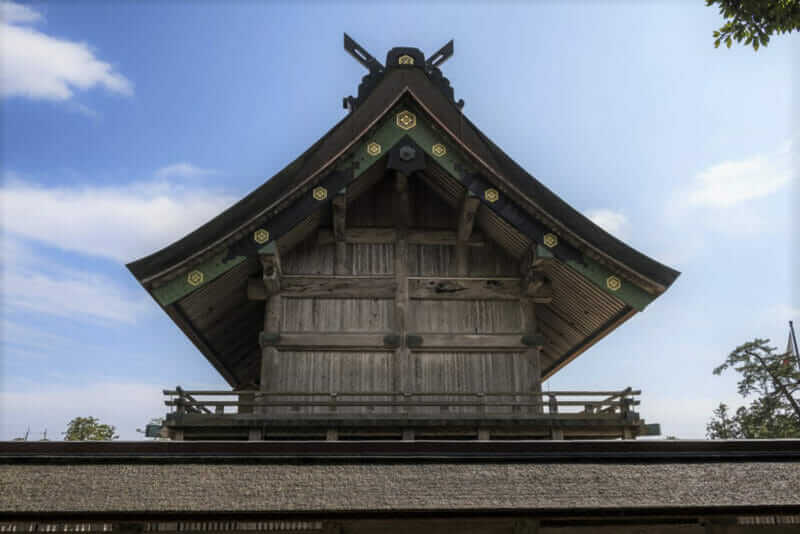
The main hall of Izumo Taisha Shrine. Its height reaches 24 meters, Izumo City, Japan = Shutterstock
Izumo Taisha (Izumo Grand Shrine = formal name is “Izumo Ooyashiro Shirine”) is located on the Japan Sea side of western Japan. This shrine is very popular among women, especially as god marriage. It is famous as a god who creates various bonds, not just men and women’s bonds, and is crowded with many worshipers.
Izumo Taisha is a special old shrine that appears in Japanese mythology. In the ancient times, Izumo Taisha Main Hall is said to have been about 48 meters high. Huge trees have been unearthed recently to show that they were actually about that size. The current Main Hall is approximately 24 meters tall.
As you enter the precincts of Izumo Taisha Shrine, you see a wooden building with a huge Shimenawa (sacred rope) as seen in the second picture above. This wooden building is “Kaguraden (Kagura Hall)”. In this building, traditional arts called Kagura are performed. There is “Haiden (Hall of Worship)” nearby. In the interior, there is Izumo Taisha Main Hall.
The current Main Hall was built in 1744. This wooden building is the largest in Japanese shrine building. That design is the oldest style in Japan.
This shrine tells us that a mighty power once existed in this area. It is believed that the forces eventually became dominated by the Japanese court.
In Shimane Prefecture where Izumo Taisha is located, there is Adachi Art Museum, famous for its beautiful Japanese garden. Matsue Castle in Matsue City is a must-see. The journey in Shimane prefecture will surely be wonderful memories.
Japanese best shrine: Itsukushima Shrine (Hatsukaichi Town, Hiroshima Prefecture)
Itsukushima shrine in Hiroshima prefecture is a large-scale shrine built on the sea. This shrine is the most popular tourist attraction among foreign tourists along with Fushimi-Inari Taisha Shrine in Kyoto, and it is also registered as a UNESCO World Cultural Heritage Site.
Itsukushima Shrine is on a small island called Miyajima. To be exact, it is built out from the island to the sea. This shrine was built by Taira no Kiyomori, who had virtually dominated Japan around 1168. However, Itsukushima Shrine was burned down afterwards with two fires. The current wooden buildings were built after the 13th century.
About 200 meters off the coast of Miyajima, there is a huge Torii gate, 16.6 meters high. A camphor tree of 500 to 600 years old is used for this torii gate. You can walk around the Torii gate at the low tide.
In addition, there are five-storied pagodas in Miyajima. Beyond that there is Mt. Misen at an altitude of 535 meters and a ropeway is operated. Of course you can climb by walking. The view from the top of the mountain is wonderful, so please do stroll around by all means.
Thank you for reading to the end.
Now, let’s plan to make your vacation in Japan the best experience ever!
